

Heart disease and heart attacks. Cardiovascular disease. Anatomy and Function of the Coronary Arteries. Coronary arteries supply blood to the heart muscle.
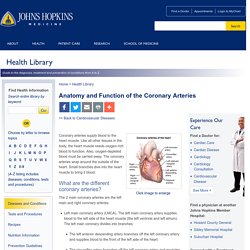
Like all other tissues in the body, the heart muscle needs oxygen-rich blood to function. Also, oxygen-depleted blood must be carried away. Your Coronary Arteries. The heart receives its own supply of blood from the coronary arteries.
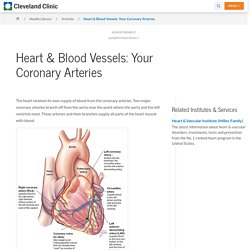
Two major coronary arteries branch off from the aorta near the point where the aorta and the left ventricle meet. These arteries and their branches supply all parts of the heart muscle with blood. Left Main Coronary Artery (also called the left main trunk) The left main coronary artery branches into: Circumflex arteryLeft Anterior Descending artery (LAD) Cardiology - Coronary Blood Supply. Coronary circulation of the heart. Khanacademy. Heart Attack Due to Atherosclerosis. Atherosclerosis - Victor Chang Cardiac Research Institute. Australian & New Zealand Society for Vascular Surgery. Coronary heart disease and atherosclerosis. Coronary heart disease (CHD), also known as ‘ischaemic heart disease’, is the most common form of heart disease.
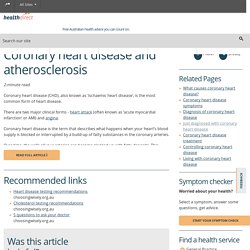
There are two major clinical forms - heart attack (often known as ‘acute myocardial infarction’ or AMI) and angina. Coronary heart disease is the term that describes what happens when your heart’s blood supply is blocked or interrupted by a build-up of fatty substances in the coronary arteries. Over time, the walls of your arteries can become clogged up with fatty deposits. This process is known as ‘atherosclerosis’ and the fatty deposits are called ‘atheroma’. Atherosclerosis can be caused by lifestyle habits and other conditions such as: If your doctor thinks you are at risk of CHD, they may carry out a risk assessment. The Royal College of Pathologists of Australia recommends that if you are over 75 years of age, you need to talk to your doctor or specialist about the risks and benefits of testing and treating your cholesterol.
National Heart, Lung, and Blood Institute (NHLBI) High Blood Pressure - Heart Research Institute. Heart disease - know your risk. Understanding your heart and stroke risk score Heart disease (cardiovascular disease, or CVD) is the leading single cause of death in Australia. 19,077 deaths were attributed to heart disease in Australia in 2016.

Cardiovascular disease can occur when arteries that supply blood and oxygen to your heart muscle and other organs (such as the brain and kidneys) become clogged with fatty material called plaque or atheroma. This process is called atherosclerosis. It can start when you are young and be well advanced by the time you reach middle age. If your arteries become too narrow, less blood can reach your heart muscle. There is no single thing that causes cardiovascular disease (CVD), but there are several risk factors that contribute to it. Unhealthy eating overweight or obesity physical inactivity smoking high cholesterol high blood pressure diabetes depression social isolation and lack of social support age being male having a family history of CVD. Risk Factors for Cardiovascular Disease (CVD) Risk Factors - Heart Research Australia. What causes a heart attack? Risk factors - World Heart Federation - World Heart Federation. The impact of social determinants on cardiovascular disease.
Cardiovascular Risk Factors. Insights From Framingham Heart Study. Epidemiology is the study of disease frequency and its determinants in the population.1 The term derives its meaning from the word epidemic, and in the first half of the last century the major epidemics were infectious disease outbreaks.

With the discovery of antibiotics2 and the implementation of public health measures to control the spread of these diseases,3 mortality due to infections decreased and life expectancy increased. Full text. Absolute CVD Risk Full Guidelines. Bulletin24. Managing cardiovascular disease in Aboriginal and Torres Strait Islander people. Socioeconomic status and risk factors for cardiovascular disease: Impact of dietary mediators. JavaScript is disabled on your browser.
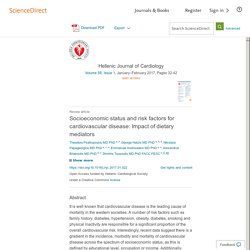
Please enable JavaScript to use all the features on this page. Open Access funded by Hellenic Cardiological Society Abstract It is well known that cardiovascular disease is the leading cause of mortality in the western societies. A number of risk factors such as family history, diabetes, hypertension, obesity, diabetes, smoking and physical inactivity are responsible for a significant proportion of the overall cardiovascular risk. Keywords Diet. ETHNIC DIFFERENCES IN CARDIOVASCULAR DISEASE.
Why heart disease is on the rise in South Africa. In South Africa, 210 people die from heart disease every day.
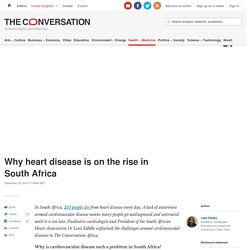
A lack of awareness around cardiovascular disease means many people go undiagnosed and untreated until it is too late. Paediatric cardiologist and President of the South African Heart Association Dr Liesl Zühlke explained the challenges around cardiovascular diseases to The Conversation Africa. Why is cardiovascular disease such a problem in South Africa? CHC: Cardiovascular disease (CVD) and women - Women's Health Victoria. Links to online resources available from the Women’s Health Victoria Clearinghouse collection.
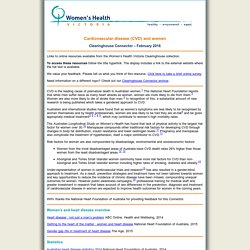
To access these resources follow the title hyperlink. The display includes a link to the external website where the full text is available. We value your feedback. Please tell us what you think of this resource. Click here to take a brief online survey Need information on a different topic? CVD is the leading cause of premature death in Australian women.1 The National Heart Foundation reports that while men suffer twice as many heart attacks as women, women are more likely to die from them.2 Women are also more likely to die of stroke than men.3 In recognition of this, a substantial amount of new research is being published which takes a gendered approach to CVD. Lack of exercise becomes leading health risk for Australian women over 30. PHYSICAL inactivity has become the greatest health risk factor for women over 30 – posing more of a threat than smoking, obesity and high blood pressure.

Research to be released today by the University of Queensland will show that women who don’t exercise are at the greatest risk of heart disease, Australia’s biggest killer. More news... DOLE: If you live in these five communities, you’ll work for your dole PREGNANT: Woman stoned to death in frontof court - by her family CRIME: Car passenger draws ‘large knife’ and slits driver’s throat NRL: Brisbane Broncos embroiled in salary-cap probe GET YOUR NEWS ON FACEBOOK The health of more than 32,000 Australian women was tracked to compile the research, published in the British Journal of Sports Medicine. University of Queensland research professor Wendy Brown said the research showed women needed to move more.
The study is one of the first in developed countries to look at how inactivity affects adult women. Physical Activity - 2014. Preamble The World Health Organisation defines physical activity as any bodily movement produced by skeletal muscles that requires energy expenditure.

Physical activity can take a number of forms. Exercise is a form of physical activity that is generally planned, structured, and repetitive which aims to improve or maintain one or more aspects of physical fitness.1 Sport also requires physical exertion, and or physical skill, which by its nature or organisation is competitive.2Incidental activity is physical activity that is undertaken as part of carrying out normal daily life, such as climbing the stairs or walking the dog.3 Physical activity can also be categorised in terms of its function and effect, including resistance, aerobic, incidental, and active transport. While physical activity forms part of the body’s energy balance equation, all too often the benefits of physical activity are only considered in relation to obesity and weight loss. Current trends. The cost of physical inactivity 08. One-in-three-risk-early-death-due-to-lack-of-exercise-20170403-gvc3dk.
Aihw bod 16. Physical Activity and Risk of Cardiovascular Disease Among Older Adults. (5) Fact or Fiction? Debunking Exercise & Nutrition Myths for Preventing Heart Disease & Risk Factors. Cardiovascular benefits of exercise. Exercise and cardiac health: physiological and molecular insights.